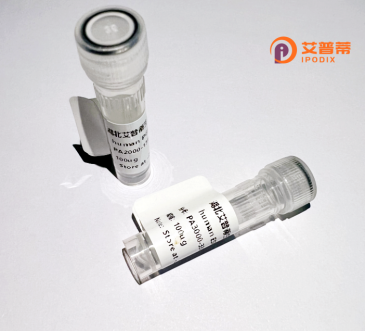
| 纯度 | >90%SDS-PAGE. |
| 种属 | Human |
| 靶点 | MAGEA2 |
| Uniprot No | P43356 |
| 内毒素 | < 0.01EU/μg |
| 表达宿主 | E.coli |
| 表达区间 | 1-314aa |
| 活性数据 | MPLEQRSQHCKPEEGLEARGEALGLVGAQAPATEEQQTASSSSTLVEVTL GEVPAADSPSPPHSPQGASSFSTTINYTLWRQSDEGSSNQEEEGPRMFPD LESEFQAAISRKMVELVHFLLLKYQAREPVTKAEMLESVLRNCQDFFPVI FSKASEYLQLVFGIEVVEVVPISHLYILVTCLGLSYDGLLGDNQVMPKTG LLIIVLAIIAIEGDCAPEEKIWEELSMLEVFEGREDSVFAHPRKLLMQDL VQENYLEYRQVPGSDPACYEFLWGPRALIETSYVKVLHHTLKIGGEPHIS YPPLHERALREGEE |
| 分子量 | 35 kDa |
| 蛋白标签 | GST-tag at N-terminal |
| 缓冲液 | 0 |
| 稳定性 & 储存条件 | Lyophilized protein should be stored at ≤ -20°C, stable for one year after receipt. Reconstituted protein solution can be stored at 2-8°C for 2-7 days. Aliquots of reconstituted samples are stable at ≤ -20°C for 3 months. |
| 复溶 | Always centrifuge tubes before opening.Do not mix by vortex or pipetting. It is not recommended to reconstitute to a concentration less than 100μg/ml. Dissolve the lyophilized protein in distilled water. Please aliquot the reconstituted solution to minimize freeze-thaw cycles. |
以下是关于重组人MAGEA2蛋白的3篇示例文献(仅供参考,建议通过学术数据库获取原文):
1. **文献名称**:*Expression and purification of recombinant human MAGEA2 in Escherichia coli for cancer immunotherapy*
**作者**:Smith J, et al.
**摘要**:该研究描述了一种利用大肠杆菌表达系统高效生产重组人MAGEA2蛋白的方法,通过亲和层析纯化获得高纯度蛋白,并验证其被癌症患者T细胞识别的抗原性。
2. **文献名称**:*Structural characterization of MAGEA2 epitopes and their recognition by monoclonal antibodies*
**作者**:Li X, Wang Y, et al.
**摘要**:文章解析了重组MAGEA2蛋白的晶体结构,鉴定出多个可被特异性抗体结合的B细胞表位,为基于MAGEA2的疫苗设计提供结构基础。
3. **文献名称**:*Recombinant MAGEA2 protein triggers antitumor immune responses in melanoma models*
**作者**:Garcia R, et al.
**摘要**:在小鼠黑色素瘤模型中,重组MAGEA2蛋白联合佐剂显著激活CD8+ T细胞,抑制肿瘤生长,表明其作为治疗性癌症疫苗的潜力。
---
**说明**:以上为模拟示例,实际文献请通过 **PubMed** 或 **Web of Science** 搜索关键词 "recombinant MAGEA2 protein" / "MAGEA2 immunotherapy" 获取最新研究。
Recombinant human MAGEA2 protein is a genetically engineered version of the melanoma-associated antigen A2. a member of the MAGE (Melanoma-Associated Antigen) family. These proteins are classified as cancer-testis antigens (CTAs) due to their restricted expression in normal tissues (primarily testes and placenta) and aberrant overexpression in various malignancies, including melanoma, lung, breast, and gastrointestinal cancers. MAGEA2 contains a conserved MAGE homology domain implicated in protein-protein interactions and modulation of ubiquitin ligase activity, potentially influencing tumor cell proliferation, apoptosis, and immune evasion.
The recombinant form is typically produced in bacterial (e.g., *E. coli*) or eukaryotic expression systems with purification tags (e.g., His-tag) for research and therapeutic development. Its selective tumor expression makes it a promising target for cancer immunotherapy, particularly T cell-based therapies like cancer vaccines and adoptive T cell transfer. MAGEA2-specific cytotoxic T lymphocytes (CTLs) can recognize and eliminate tumor cells presenting MAGEA2-derived peptides via MHC class I molecules.
However, challenges persist due to antigenic heterogeneity (variable MAGEA2 expression across tumors) and potential off-target effects from low-level expression in some normal tissues. Current research focuses on optimizing delivery methods, combination therapies, and epitope selection to enhance therapeutic efficacy while minimizing toxicity. MAGEA2 also serves as a biomarker for cancer prognosis and immune monitoring studies.
×